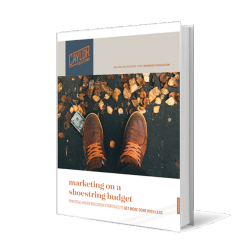Crisis Communication in Higher Ed: Pepperdine’s Wildfire Response
See how Pepperdine University redefined crisis communication in higher ed by prioritizing safety, faith, and storytelling during the California wildfires.
Branding
It’s one of those words that is used so much today, but the concept can be confusing. So what exactly is an education brand, and how do you build yours to attract more prospective students?
First, let’s talk about what an education brand is not. An education brand is not a school logo. A brand is not a tagline. An education brand is not a color scheme or assigned typography.
All of these are elements of your brand. But they are not your education brand.
I think this is where most of us get confused about what our school’s brand is. Logos and colors are tangible things that we can wrap our heads around.
But an education brand is an abstract, intangible reality that you can’t quantify or show someone.
Tangible, visual brand elements like logos and taglines are necessary to convey or reinforce your brand. But they are not, in fact, your education brand.
The difference between your education brand and its brand elements is a vital distinction. Why?
Because to create the tangible brand elements, you must begin by articulating the intangible concepts that make up your education brand.
The beliefs, values, and worldview of your school make up our first intangible education brand component.
Your school’s ethos goes well beyond whatever is on your About Us page or corporate values statement. Your school ethos is made up of the values and dreams that you live and fight for as a school.
/ˈēTHäs/ the characteristic spirit of a culture, era, or community as manifested in its beliefs and aspirations. – Google Dictionary
School ethos is the spirit of your educational community. It’s shown in what you invest time, energy, and money into as a community.
It is possible to change your school ethos. But highly unlikely.
That’s why in working with education marketers and executives, we use a variety of methods to uncover what their true values and beliefs are.
To build your education brand, you must know clearly—without any doubt—what your corporate convictions are.
Identify your school’s ethos. Express it. Communicate it.
Whatever you do, don’t waste time trying to change your school’s ethos to match what other schools are doing. Your school spirit is one of your greatest advantages.
For most schools, their campus is a real treasure. In fact, a donor or two probably gave a lot of “treasure” to make your beautiful campus possible!

Sterling College emphasizes their environmentally-conscious values through images of their campus. Image via Katie Lavin. https://sterlingcollege.edu/news-room/sterling-college-recognized-top-performer-2017-sustainable-campus-index/
As noticeable as it is, this component of the education brand is often missed or ignored by school marketers.
Sometimes the campus you see every day fades into the background. As an insider, you no longer notice the bright colors of an autumn day, the rich culture of campus sculptures, the unique quality of the architecture.
It’s human nature to lose our sense of wonder as our surroundings become normal for us. But your campus atmosphere can often be a huge selling point for prospective students who want a wilderness escape, a sustainable agricultural commune, or a diverse urban experience.
Consider how you can leverage your campus atmosphere to convey your education brand.
Invest in high-quality photography and videography. Place this rich content throughout your website and printed materials. Use your campus landscapes to help you form your education brand.
What are you promising to your prospective students? To your donors? To your alumni? To the general public?
This is the one intangible component that you have the most control over as the education marketer.
You can write into your marketing materials exactly what your school has to offer. Or write out a moving case for support to your donor base.
But you can also make brand promises through rich content like images and video.
When your audience sees your students socializing, they intuitively understand that your brand is promising a welcoming and accepting educational experience. When they watch videos of your students in the lab, they get it that you’re committed to a hands-on approach to learning.
Write out the promises that you are going to make in your marketing messaging for internal use. Aim for clarity more than elegance in these internal documents.
Then, as you create and distribute marketing content, draw from your internal brand promises (sometimes called “brand descriptions” or ”brand statements”) to craft the message you’re sending out.
The way your audiences perceive you is the intangible component of which you have the least control. You can’t control the impressions people have of you, or how they talk about you.
However, you can do a WHOLE lot to give yourself a fighting chance at improving the way your audiences see your education brand. Here are some thoughts from previous blog posts I’ve written about this:
If you were to cross Lake Michigan in a rowboat, you wouldn’t look across the bow to where you’re going. To keep rowing—and thereby keep moving forward—you have to look back across the stern to where you came from.

John Wesley statue at Indiana Wesleyan University. Via Wikipedia. Public Domain.
In the same way, if you want to move forward into the future of your school, you will have to take some time to absorb the implications of your institution’s past.
You could write out the story these questions reveal in your About Us section, as a lot of schools do. No problem with that.
But if you want to go light-years ahead of your competitors, find ways to incorporate your school’s history into your brand messaging and elements.
Your educational brand is your most valuable marketing asset. Guard and articulate it well, and you’ll find greater success in your education marketing.
For help developing your education brand, set up your free consultation today!
Set yourself free from your shrinking marketing budget with my popular ebook Marketing on a Shoestring Budget! This ebook is jammed with practical ways to produce high-quality marketing on the cheap.
Inside, I’ll show you proven marketing tactics like…
No hype. No pie in the sky. Just real solutions for getting the job done with the budget you’ve got.
Featured image by Tomasz Zajda via Adobe Stock
Subscribe to The Higher Ed Marketer podcast today!